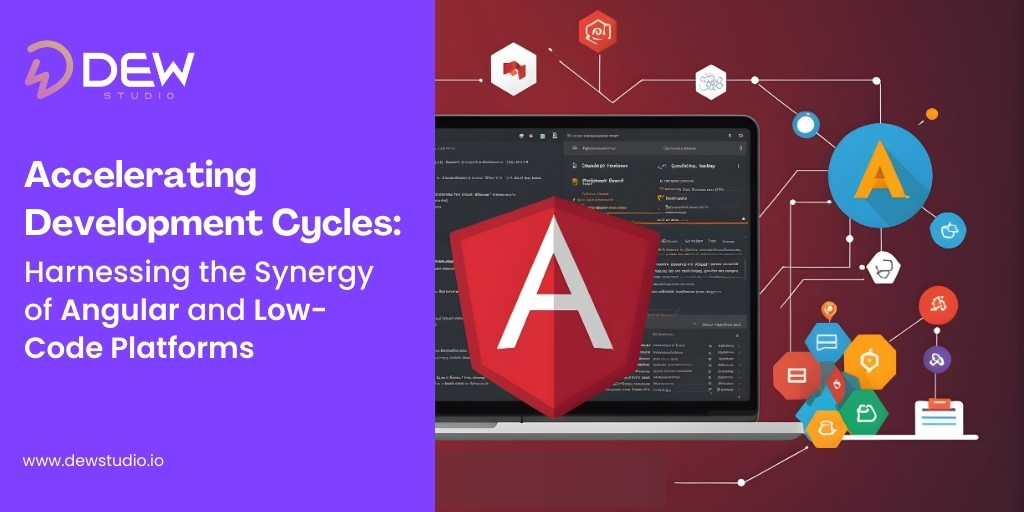
Angular has emerged as a cornerstone technology, rapidly gaining traction and popularity. Simultaneously, the low-code platform craze is sweeping through the industry, offering intuitive interfaces and simplified development processes. Angular versatility, robustness, and extensive community support have propelled it to the forefront of web application development. And, in the same manner, the Low Code platform promise of faster deployment and reduced reliance on traditional coding. As a result businesses striving to streamline development cycles and enhance productivity, harnessing the synergy between Angular and low-code platforms presents an enticing proposition.
This blog explores how leveraging Angular alongside low-code platforms can accelerate development cycles, fostering innovation and efficiency in software engineering endeavours.
Angular
Angular, developed and maintained by Google. It is one of the comprehensive frameworks allowing to build dynamic web applications.
Key Features
Include a modular architecture, two-way data binding, and dependency injection, which enhance development efficiency and maintainability.
Angular’s robust tooling and extensive ecosystem contribute to its popularity among developers worldwide.
Challenges:
Despite its strengths, Angular also poses challenges. For beginners & frequent updates requiring codebase adjustments. Additionally, large-scale Angular projects may suffer from performance issues due to its complex rendering process. Nonetheless, Angular remains a powerful choice for building modern web applications, offering a balance of flexibility and structure for developers.
Low Code
Low-code platforms are software development tools that enable users to build applications with minimal hand-coding, primarily through visual interfaces and drag-and-drop components.
Advantages
Accelerate development cycles, reduced reliance on technical expertise, and increased collaboration between business users and IT professionals.
Offer faster time-to-market, lower development costs, and greater agility in responding to changing business requirements.
Popular low-code platforms in the market include DEWStudio offering a range of features and customization options to suit various project needs. With their intuitive interfaces and pre-built functionalities, low-code platforms empower organizations to innovate and deliver software solutions more efficiently than ever before.
Synergy Between Angular and Low Code Platforms:
The synergy between Angular and low-code platforms lies in their complementary strengths, fostering a symbiotic relationship that enhances development processes.
The robust framework and powerful capabilities of angular, is well-suited for handling complex logic and extensive customization requirements. Developers can leverage Angular’s expertise in building scalable and feature-rich applications, integrating it seamlessly with Low Code platforms.
On the other hand, Low Code platforms excel in rapid prototyping and front-end development, offering intuitive interfaces and pre-built components for accelerated application development.
Combining Angular’s depth with Low Code platforms‘ agility, organizations can achieve faster time-to-market and greater flexibility in responding to evolving business needs. Case studies, such as integrating Angular with OutSystems for enterprise-level application development or combining Angular with Mendix for streamlined workflow management, demonstrate the successful integration of these technologies in real-world scenarios. This synergy empowers development teams to leverage the best of both worlds, maximizing productivity and innovation while delivering high-quality software solutions efficiently.
Accelerating Development Cycles with Angular and Low-Code Platforms:
Accelerating development cycles with the combination of Angular and low-code platforms involves several strategic approaches.
Firstly, optimizing development cycles entails leveraging Angular’s capabilities for complex logic and customization alongside low-code platforms for rapid prototyping and front-end development.
Streamlining workflows involves establishing clear communication channels and collaboration tools to facilitate seamless interaction between developers and business stakeholders.
Additionally, addressing common challenges in integrating Angular with low-code platforms requires thorough planning and expertise to overcome technical complexities and ensure smooth integration.
Real-world examples, such as a healthcare company using Angular with Low Code platform to develop a patient management system, showcase how this approach can lead to faster time-to-market by reducing development efforts and enabling rapid iteration cycles. By implementing these strategies, organizations can effectively harness the synergy between Angular and low-code platforms to accelerate development cycles and achieve business objectives more efficiently.
Practices and Tips:
Practical tips to harness the synergy of Angular and Low Code platforms, developers and organizations can benefit from several.
Firstly, it’s essential to thoroughly assess project requirements and choose a low-code platform that aligns with the project’s complexity, scalability, and integration needs.
Consider factors such as ease of use, extensibility, and ecosystem support when selecting the right platform.
Prioritize platforms that offer robust integration capabilities with Angular, ensuring seamless collaboration between front-end and back-end development teams. To maintain code quality and scalability while using Low Code platforms, adhere to coding standards and best practices recommended by both Angular and the chosen platform.
Regular code reviews, automated testing, and version control can help mitigate risks and ensure long-term maintainability. Furthermore, seek insights from industry experts and thought leaders in Angular and Low Code development to stay informed about emerging trends, best practices, and potential pitfalls. Engage with community forums, attend conferences, and leverage online resources to tap into a wealth of knowledge and expertise.
By following these best practices and leveraging insights from industry experts, developers and organizations can effectively harness the synergy of Angular and low-code platforms to accelerate development cycles and deliver high-quality software solutions efficiently.
Conlcusion
In conclusion, the combination of Angular and Low Code platforms offers numerous benefits, including accelerated development cycles, reduced time-to-market, and increased collaboration between developers and business stakeholders. The importance of agility and speed in modern software development cannot be overstated, as organizations strive to meet evolving market demands and deliver innovative solutions quickly.
Therefore, it is crucial for developers and organizations to explore the potential of this powerful combination to stay ahead of the curve and drive meaningful impact. Looking ahead, the future of development cycles holds promising opportunities with the continued advancement of emerging technologies. By embracing Angular and such platforms, businesses can unlock new levels of efficiency and innovation, shaping the landscape of software development for years to come.


